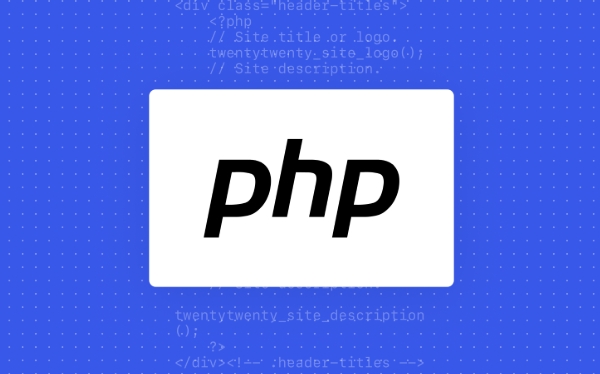The core method to prevent SQL injection is to use preprocessing statements and parameterized queries. 1. Use PDO preprocessing statements to bind user input through question marks or named parameters to ensure that the input is not executed as SQL code; 2. Use mysqli's preprocessing and bind_param method to clearly specify the parameter type to prevent malicious input from tampering with SQL structure; 3. Avoid manually escape input, such as mysqli_real_escape_string, because it is prone to errors and insufficient security; 4. Use PHP built-in filter functions to verify input, such as filter_input and intval, to ensure the legality of the input data. These methods can effectively improve the security of PHP applications and prevent SQL injection attacks.

Preventing SQL Injection is a very basic but critical security measure in PHP development. Directly splicing SQL statements is very dangerous. Attackers can tamper with SQL logic by constructing malicious input, or even delete or steal data. PHP provides a variety of ways to prevent SQL injections, and here are some practical methods.

Use Prepared Statements
This is the most recommended way. Preprocessing statements ensure that user input is not executed as SQL code by processing SQL statements and parameters separately.
Take PDO (PHP Data Objects) as an example:

$pdo = new PDO('mysql:host=localhost;dbname=test', 'user', 'password'); $stmt = $pdo->prepare('SELECT * FROM users WHERE username = ? AND password = ?'); $stmt->execute([$username, $password]); $user = $stmt->fetch();
You can also use named parameters to make the code clearer:
$stmt = $pdo->prepare('SELECT * FROM users WHERE username = :username AND password = :password'); $stmt->execute(['username' => $username, 'password' => $password]);
This method can effectively prevent SQL injections because the parameters are later bound and will not affect the original SQL structure.

Use mysqli's binding parameter function
If you are using the mysqli extension, you can also use its preprocessing function:
$mysqli = new mysqli("localhost", "user", "password", "test");
$stmt = $mysqli->prepare("INSERT INTO users (username, email) VALUES (?, ?)");
$stmt->bind_param("ss", $username, $email);
$stmt->execute();
$stmt->close(); Here "ss" means two string parameters. This method can also effectively prevent SQL injections.
Not recommended: Manual escape input
Although mysqli_real_escape_string() can escape input strings, this method is not safe and error-prone, and is not recommended:
$username = mysqli_real_escape_string($mysqli, $_POST['username']); $query = "SELECT * FROM users WHERE username = '$username'";
This writing method looks simple, but it is easy to leave loopholes due to splicing logic errors. For example, if you forget to add quotes when splicing numeric fields, the attacker can inject it.
Additional suggestions: Verify and filter input
In addition to using preprocessing statements, you can also verify user input with PHP filtering functions, for example:
$email = filter_input(INPUT_POST, 'email', FILTER_VALIDATE_EMAIL);
This allows filtering out illegal input before executing SQL, further improving security.
In addition, for numeric inputs, you can use intval() or FILTER_VALIDATE_INT to ensure that the input is an integer:
$id = intval($_GET['id']);
Basically that's it. The core of preventing SQL injections is to not treat user input as part of SQL, but to use parameterized queries. Although the method seems simple, it is easily overlooked in actual development. As long as you develop the habit of using preprocessing statements, the risk of SQL injection can be greatly reduced.
The above is the detailed content of php function to prevent sql injection. For more information, please follow other related articles on the PHP Chinese website!

Hot AI Tools

Undress AI Tool
Undress images for free

Undresser.AI Undress
AI-powered app for creating realistic nude photos

AI Clothes Remover
Online AI tool for removing clothes from photos.

Clothoff.io
AI clothes remover

Video Face Swap
Swap faces in any video effortlessly with our completely free AI face swap tool!

Hot Article

Hot Tools

Notepad++7.3.1
Easy-to-use and free code editor

SublimeText3 Chinese version
Chinese version, very easy to use

Zend Studio 13.0.1
Powerful PHP integrated development environment

Dreamweaver CS6
Visual web development tools

SublimeText3 Mac version
God-level code editing software (SublimeText3)
 PHP Variable Scope Explained
Jul 17, 2025 am 04:16 AM
PHP Variable Scope Explained
Jul 17, 2025 am 04:16 AM
Common problems and solutions for PHP variable scope include: 1. The global variable cannot be accessed within the function, and it needs to be passed in using the global keyword or parameter; 2. The static variable is declared with static, and it is only initialized once and the value is maintained between multiple calls; 3. Hyperglobal variables such as $_GET and $_POST can be used directly in any scope, but you need to pay attention to safe filtering; 4. Anonymous functions need to introduce parent scope variables through the use keyword, and when modifying external variables, you need to pass a reference. Mastering these rules can help avoid errors and improve code stability.
 How to handle File Uploads securely in PHP?
Jul 08, 2025 am 02:37 AM
How to handle File Uploads securely in PHP?
Jul 08, 2025 am 02:37 AM
To safely handle PHP file uploads, you need to verify the source and type, control the file name and path, set server restrictions, and process media files twice. 1. Verify the upload source to prevent CSRF through token and detect the real MIME type through finfo_file using whitelist control; 2. Rename the file to a random string and determine the extension to store it in a non-Web directory according to the detection type; 3. PHP configuration limits the upload size and temporary directory Nginx/Apache prohibits access to the upload directory; 4. The GD library resaves the pictures to clear potential malicious data.
 Commenting Out Code in PHP
Jul 18, 2025 am 04:57 AM
Commenting Out Code in PHP
Jul 18, 2025 am 04:57 AM
There are three common methods for PHP comment code: 1. Use // or # to block one line of code, and it is recommended to use //; 2. Use /.../ to wrap code blocks with multiple lines, which cannot be nested but can be crossed; 3. Combination skills comments such as using /if(){}/ to control logic blocks, or to improve efficiency with editor shortcut keys, you should pay attention to closing symbols and avoid nesting when using them.
 How Do Generators Work in PHP?
Jul 11, 2025 am 03:12 AM
How Do Generators Work in PHP?
Jul 11, 2025 am 03:12 AM
AgeneratorinPHPisamemory-efficientwaytoiterateoverlargedatasetsbyyieldingvaluesoneatatimeinsteadofreturningthemallatonce.1.Generatorsusetheyieldkeywordtoproducevaluesondemand,reducingmemoryusage.2.Theyareusefulforhandlingbigloops,readinglargefiles,or
 Tips for Writing PHP Comments
Jul 18, 2025 am 04:51 AM
Tips for Writing PHP Comments
Jul 18, 2025 am 04:51 AM
The key to writing PHP comments is to clarify the purpose and specifications. Comments should explain "why" rather than "what was done", avoiding redundancy or too simplicity. 1. Use a unified format, such as docblock (/*/) for class and method descriptions to improve readability and tool compatibility; 2. Emphasize the reasons behind the logic, such as why JS jumps need to be output manually; 3. Add an overview description before complex code, describe the process in steps, and help understand the overall idea; 4. Use TODO and FIXME rationally to mark to-do items and problems to facilitate subsequent tracking and collaboration. Good annotations can reduce communication costs and improve code maintenance efficiency.
 How to access a character in a string by index in PHP
Jul 12, 2025 am 03:15 AM
How to access a character in a string by index in PHP
Jul 12, 2025 am 03:15 AM
In PHP, you can use square brackets or curly braces to obtain string specific index characters, but square brackets are recommended; the index starts from 0, and the access outside the range returns a null value and cannot be assigned a value; mb_substr is required to handle multi-byte characters. For example: $str="hello";echo$str[0]; output h; and Chinese characters such as mb_substr($str,1,1) need to obtain the correct result; in actual applications, the length of the string should be checked before looping, dynamic strings need to be verified for validity, and multilingual projects recommend using multi-byte security functions uniformly.
 Quick PHP Installation Tutorial
Jul 18, 2025 am 04:52 AM
Quick PHP Installation Tutorial
Jul 18, 2025 am 04:52 AM
ToinstallPHPquickly,useXAMPPonWindowsorHomebrewonmacOS.1.OnWindows,downloadandinstallXAMPP,selectcomponents,startApache,andplacefilesinhtdocs.2.Alternatively,manuallyinstallPHPfromphp.netandsetupaserverlikeApache.3.OnmacOS,installHomebrew,thenrun'bre
 Learning PHP: A Beginner's Guide
Jul 18, 2025 am 04:54 AM
Learning PHP: A Beginner's Guide
Jul 18, 2025 am 04:54 AM
TolearnPHPeffectively,startbysettingupalocalserverenvironmentusingtoolslikeXAMPPandacodeeditorlikeVSCode.1)InstallXAMPPforApache,MySQL,andPHP.2)Useacodeeditorforsyntaxsupport.3)TestyoursetupwithasimplePHPfile.Next,learnPHPbasicsincludingvariables,ech






